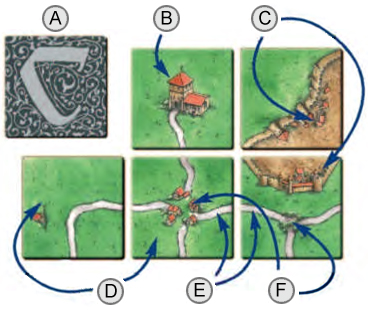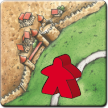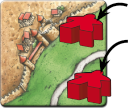Difference between revisions of "Base game (1st edition)"
m (rearanging pictures) |
Meepledrone (talk | contribs) |
||
| Line 46: | Line 46: | ||
<!--T:8--> | <!--T:8--> | ||
* '''48 followers'''<ref>[[File:Icon_Open_Book.png|16px|text-bottom| | * '''48 followers'''<ref>[[File:Icon_Open_Book.png|16px|text-bottom|]] '''Question:''' Too few followers—are we playing wrong or are there really too few? '''Answer:''' In our view there are not too few. A certain shortage of followers is entirely intentional. An important element of the game is precisely learning to be economical with one's followers. | ||
[[File:Base_Game_C1_Meeples_Footer_Note_2.jpg|84px|frame|none|Follower shortage]] | |||
</ref> in six colors<ref>[[File:Icon_World_Black.png|16px|text-bottom|]] As far as the Big Box is concerned, the sixth set of (gray) followers is a part of the basic game, not Inns and Cathedrals. Additionally, Big Box 5 adds purple and pink followers for up to 8 players.</ref>: | </ref> in six colors<ref>[[File:Icon_World_Black.png|16px|text-bottom|]] As far as the Big Box is concerned, the sixth set of (gray) followers is a part of the basic game, not Inns and Cathedrals. Additionally, Big Box 5 adds purple and pink followers for up to 8 players.</ref>: | ||
| Line 106: | Line 106: | ||
<!--T:26--> | <!--T:26--> | ||
* At least one side of the new tile (with a <span style="color: red;">red</span> border in the examples below) must touch one or more tiles already in play.<ref>[[File:Icon_Open_Book.png|16px|text-bottom| | * At least one side of the new tile (with a <span style="color: red;">red</span> border in the examples below) must touch one or more tiles already in play.<ref>[[File:Icon_Open_Book.png|16px|text-bottom|]] '''Question:''' We have difficulty deciding when a placed tile represents a new city or belongs to one already being built. '''Answer:''' 'Corner to corner' is not a connection! Segments can only be connected on the edges. In the example shown there are two cities at the moment. [[File:Base_Game_C1_Sample_Note_7.jpg|frame|none|Corner to corner]]</ref> Corner-to-corner placement is not permitted. | ||
<!--T:27--> | <!--T:27--> | ||
| Line 124: | Line 124: | ||
* The follower must come from the player's supply. | * The follower must come from the player's supply. | ||
* The follower may only be deployed to the tile just placed. | * The follower may only be deployed to the tile just placed. | ||
* The player must decide which part of the tile the follower is deployed to <ref>[[File:Icon_Open_Book.png|16px|text-bottom| | * The player must decide which part of the tile the follower is deployed to <ref>[[File:Icon_Open_Book.png|16px|text-bottom|]] If you complete a previously unoccupied city when placing a tile, you do not have to occupy this city and earn the points. You can close the city without it being occupied and (for example) deploy a farmer as long as the farm is unoccupied. The city does not necessarily require a knight to look after it. [[File:Base_Game_C1_Example_Note_12.jpg|frame|none|Earning points from a closed city]] </ref> <ref>[[File:Icon_Open_Book.png|16px|text-bottom|]] '''Question:''' On cloister tiles, are we allowed to deploy a follower on the surrounding field segment? '''Answer:''' Yes! The same rules are valid for a field surrounding a cloister as for any other field. You can also deploy a farmer next to a cloister. In this case the cloister remains unoccupied for the rest of the game.[unless the cloister is occupied via a magic portal, or from a follower in Carcassonne—ed.] | ||
[[File:Base_Game_C1_Example_Note_13.jpg|frame|none|Deploying follower in a field next to a cloister]]</ref> as either: | [[File:Base_Game_C1_Example_Note_13.jpg|frame|none|Deploying follower in a field next to a cloister]]</ref> as either: | ||
| Line 154: | Line 154: | ||
<!--T:38--> | <!--T:38--> | ||
'''With the following exception:''' if a road, city or cloister was completed through the | '''With the following exception:''' if a road, city or cloister was completed through the | ||
placement of the tile, it must now be scored.<ref>[[File:Icon_Open_Book.png|16px|text-bottom| | placement of the tile, it must now be scored.<ref>[[File:Icon_Open_Book.png|16px|text-bottom|]] '''Question:''' There is a situation that puzzles us. If a player draws a tile with two city segments and completes a small city, earning 4 points, can he or she then deploy a follower to a new city segment in the same turn? | ||
'''Answer:''' A player may only deploy one follower per turn, and that follower may be deployed only once, and it must be before any scoring. If the player already occupies the small, now-completed city, he or she may deploy a second follower to the other city segment immediately after placing the tile. The small city will then be scored and the follower involved returned to the player. If the player does not yet occupy this city, he or she can decide which of the two city segments to deploy a follower to. If the follower is deployed to the small city, it will be returned immediately and the player will earn four points, but the follower cannot be redeployed.</ref> | '''Answer:''' A player may only deploy one follower per turn, and that follower may be deployed only once, and it must be before any scoring. If the player already occupies the small, now-completed city, he or she may deploy a second follower to the other city segment immediately after placing the tile. The small city will then be scored and the follower involved returned to the player. If the player does not yet occupy this city, he or she can decide which of the two city segments to deploy a follower to. If the follower is deployed to the small city, it will be returned immediately and the player will earn four points, but the follower cannot be redeployed. [[File:Base_Game_C1_Example_Note_14.jpg|frame|none|Deploying follower in a field next to a cloister]]</ref> | ||
=== <span id="Use of a Table"></span>Use of a Table === | === <span id="Use of a Table"></span>Use of a Table === | ||
Revision as of 21:49, 10 September 2018
General info and comments
originally released by Hans im Glück in 2000
A clever tile-laying game for 2 to 6 players aged 8 and above by Klaus-Jürgen Wrede
The city of Carcassonne in southern France is famous for its unique Roman and Medieval fortifications. The players take their chances with their followers in the cities, cloisters, farms and on the roads around Carcassonne. The development of the land is in their hands, and the skillful deployment of the followers as thieves, knights, monks and farmers is the path to success.
Contents
- 72 land tiles (including one with a dark reverse) which depict road, city and field segments, as well as cloisters and crossings.[1]
Each follower can be deployed as a knight, monk, thief or farmer. One follower of each color is used as a scoring marker.
- One scoreboard. This is used to track players' scores
- One rule booklet and one supplement.
Rules
Overview
The players place the land tiles turn by turn. This leads to the growth of roads, cities, cloisters and farms, to which the players may deploy their followers in order to earn points. As points can be won during the game as well as at the end, the winner will only emerge during the final scoring.
Preparation
The starting tile is placed in the middle of the table.[4] The remaining tiles are mixed and placed face-down on the table in several stacks, so that each player can access them easily.[5] The scoreboard should be placed at the edge of the table if possible.
Each player chooses a color and receives the eight followers, placing one on the ‘0’ field of the scoreboard as a scoring marker. The remaining seven followers stay with the player for the moment, as his or her supply.
The youngest player decides who starts the game.[6]
Playing the game
Play progresses in a clockwise fashion. The player whose turn it is carries out the following actions in the order given:
- The player must draw one new land tile and place it.
- The player may draw one follower from his or her supply and deploy it to the tile just placed.
- If any roads, cities, or cloisters are completed through the placement of the tile, they must be scored now.
Then it is the next player's turn.
1. Place a tile
As their first action, the player must draw a tile from one of the stacks. The tile is then shown to the other players (so they can ‘advise’ the player about where to place it) and placed on the table. The player must take care to observe the following points:
- At least one side of the new tile (with a red border in the examples below) must touch one or more tiles already in play.[7] Corner-to-corner placement is not permitted.
In the rare case that a tile cannot legally be placed anywhere, and all players agree, it is removed from the game, and the player draws another.[10] [11]
2. Deploy a follower
When the player has placed the tile, he or she may deploy a follower. In doing so the following points must be observed:
- Only one follower may be deployed each turn.
- The follower must come from the player's supply.
- The follower may only be deployed to the tile just placed.
- The player must decide which part of the tile the follower is deployed to [12] [13] as either:
- There must be no other follower (not even one belonging to the same player) on the road, city, or field segments connected to the tile just placed. It does not matter how far away the follower is. The following two examples may help to explain:
If a player runs out of followers during the course of play, he or she may only place tiles. But don't panic: you can also get followers back.
Now the player’s turn is over, and it is the turn of the next player on the left.
With the following exception: if a road, city or cloister was completed through the placement of the tile, it must now be scored.[14]
Use of a Table
Lorem ipsum
Footnotes
For Icons explanation and licensing please visit Icons page.
- ↑
 The RGG edition of the Big Box 1, which includes The River, adds the following sentence here:
“The 12 river tiles are NOT part of the basic game but do have the same back as the starting tile.”
The RGG edition of the Big Box 1, which includes The River, adds the following sentence here:
“The 12 river tiles are NOT part of the basic game but do have the same back as the starting tile.”
- ↑
 Question: Too few followers—are we playing wrong or are there really too few? Answer: In our view there are not too few. A certain shortage of followers is entirely intentional. An important element of the game is precisely learning to be economical with one's followers.
Question: Too few followers—are we playing wrong or are there really too few? Answer: In our view there are not too few. A certain shortage of followers is entirely intentional. An important element of the game is precisely learning to be economical with one's followers.
- ↑
 As far as the Big Box is concerned, the sixth set of (gray) followers is a part of the basic game, not Inns and Cathedrals. Additionally, Big Box 5 adds purple and pink followers for up to 8 players.
As far as the Big Box is concerned, the sixth set of (gray) followers is a part of the basic game, not Inns and Cathedrals. Additionally, Big Box 5 adds purple and pink followers for up to 8 players.
- ↑
 See notes on Use of a Table (5/2013)
See notes on Use of a Table (5/2013)
- ↑ File:Icon House Blue.png Tiles can also be placed into a sack and drawn randomly.
- ↑
 This paragraph represents the current HiG rules. The RGG rules state that the players decide among themselves who will be the starting player, and the ZMG rules mention both options.
This paragraph represents the current HiG rules. The RGG rules state that the players decide among themselves who will be the starting player, and the ZMG rules mention both options.
- ↑
 Question: We have difficulty deciding when a placed tile represents a new city or belongs to one already being built. Answer: 'Corner to corner' is not a connection! Segments can only be connected on the edges. In the example shown there are two cities at the moment.
Question: We have difficulty deciding when a placed tile represents a new city or belongs to one already being built. Answer: 'Corner to corner' is not a connection! Segments can only be connected on the edges. In the example shown there are two cities at the moment.
- ↑
 Cloisters can be placed directly next to each other, or corner to corner. It is not necessary for there to be eight other (non-cloister) tiles neighbouring a cloister. A cloister stands in the middle of a field segment and other segments can be placed next to it. In contrast to roads, cities, and fields, it is not possible to connect to a cloister.
Cloisters can be placed directly next to each other, or corner to corner. It is not necessary for there to be eight other (non-cloister) tiles neighbouring a cloister. A cloister stands in the middle of a field segment and other segments can be placed next to it. In contrast to roads, cities, and fields, it is not possible to connect to a cloister.
- ↑
 A newly placed land tile must fit the adjacent terrain on all edges. During placement it is not enough to look for only one side that fits.
A newly placed land tile must fit the adjacent terrain on all edges. During placement it is not enough to look for only one side that fits.
- ↑
 Alternatively, if legal, the player could place the Abbey tile instead of drawing another tile. (1/2013)
Alternatively, if legal, the player could place the Abbey tile instead of drawing another tile. (1/2013)
- ↑ File:Icon House Blue.png If drawing tiles out of a bag, a tile that cannot be placed could be returned to the bag for later use.
- ↑
 If you complete a previously unoccupied city when placing a tile, you do not have to occupy this city and earn the points. You can close the city without it being occupied and (for example) deploy a farmer as long as the farm is unoccupied. The city does not necessarily require a knight to look after it.
If you complete a previously unoccupied city when placing a tile, you do not have to occupy this city and earn the points. You can close the city without it being occupied and (for example) deploy a farmer as long as the farm is unoccupied. The city does not necessarily require a knight to look after it.
- ↑
 Question: On cloister tiles, are we allowed to deploy a follower on the surrounding field segment? Answer: Yes! The same rules are valid for a field surrounding a cloister as for any other field. You can also deploy a farmer next to a cloister. In this case the cloister remains unoccupied for the rest of the game.[unless the cloister is occupied via a magic portal, or from a follower in Carcassonne—ed.]
Question: On cloister tiles, are we allowed to deploy a follower on the surrounding field segment? Answer: Yes! The same rules are valid for a field surrounding a cloister as for any other field. You can also deploy a farmer next to a cloister. In this case the cloister remains unoccupied for the rest of the game.[unless the cloister is occupied via a magic portal, or from a follower in Carcassonne—ed.]
- ↑
 Question: There is a situation that puzzles us. If a player draws a tile with two city segments and completes a small city, earning 4 points, can he or she then deploy a follower to a new city segment in the same turn?
Answer: A player may only deploy one follower per turn, and that follower may be deployed only once, and it must be before any scoring. If the player already occupies the small, now-completed city, he or she may deploy a second follower to the other city segment immediately after placing the tile. The small city will then be scored and the follower involved returned to the player. If the player does not yet occupy this city, he or she can decide which of the two city segments to deploy a follower to. If the follower is deployed to the small city, it will be returned immediately and the player will earn four points, but the follower cannot be redeployed.
Question: There is a situation that puzzles us. If a player draws a tile with two city segments and completes a small city, earning 4 points, can he or she then deploy a follower to a new city segment in the same turn?
Answer: A player may only deploy one follower per turn, and that follower may be deployed only once, and it must be before any scoring. If the player already occupies the small, now-completed city, he or she may deploy a second follower to the other city segment immediately after placing the tile. The small city will then be scored and the follower involved returned to the player. If the player does not yet occupy this city, he or she can decide which of the two city segments to deploy a follower to. If the follower is deployed to the small city, it will be returned immediately and the player will earn four points, but the follower cannot be redeployed.













